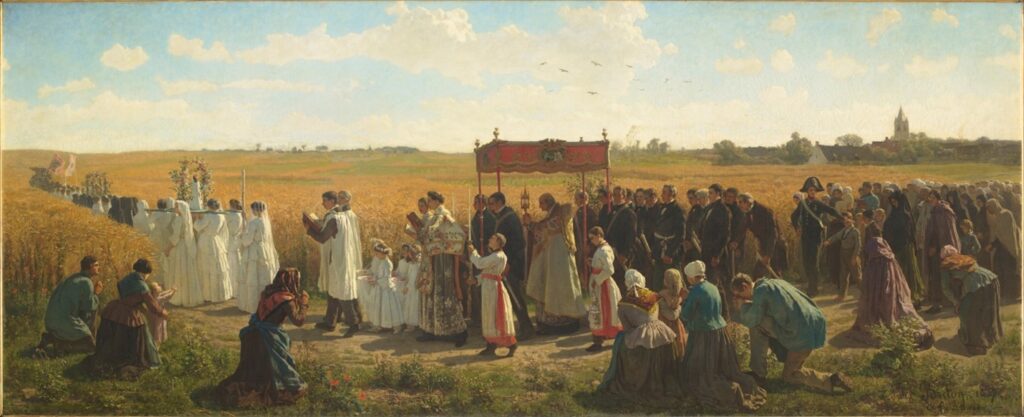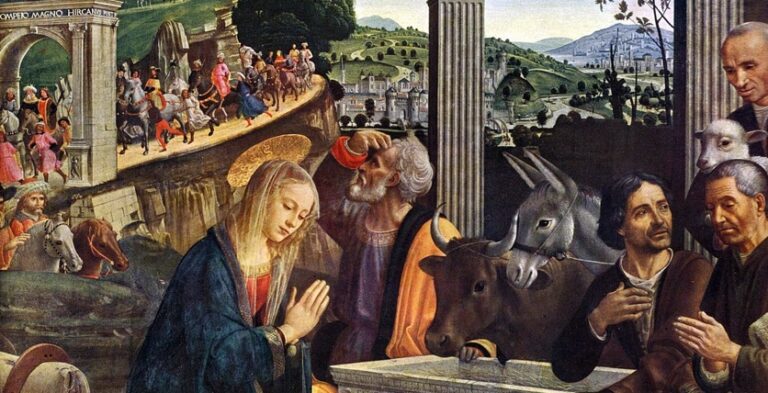
CORPUS CHRISTI
One of the traditional features of the Solemnity of Corpus Christi is a liturgical procession. Processions were a significant feature of the 19th century church as shown here in this painting of a Rogation Day procession through the wheat fields of northern France.

You can see the priest holding the monstrance under the canopy accompanied by other clergy, women in white carrying a statue of Our Lady, children, village officials and villagers bringing up the rear. Alongside the procession route we see people kneel before the host. They are blessed by the Christ-bearing church moving among them.
This is an image of the rural parish as it was when 80 percent of us lived in the countryside and villages. Now 80 percent of us live in cities and towns. Our parishes are urban with few wheat fields in sight. Why do we still need processions today? Are they nostalgic reminiscences of the way the Church used to be or is there a new relevance for them in our age of emotional exhaustion and existential worry?
In a Corpus Christi procession, Christ leaves the altar, continues down the nave and carries on into the streets surrounding the Church. We are bringing Christ into our community. But this is more than an outing from our confined sacred worship spaces, this is an act of blessing. We process through the streets with our incense and hymns, our rosaries and litanies to bless the places and people in our community.
We carry this sacred blessing past the repair shops and apartment buildings, the offices and food banks, the schools and hospitals of our community. We bless these places with Christ’s presence. We admit our incompleteness but nonetheless proclaim the holiness of the place where we live. We walk among weeds and broken glass knowing that even these can be redeemed.
We think of the Biblical precedents for the Corpus Christi procession: Mary and Joseph fleeing to Egypt and their return; Jesus leading the disciples through Galilee; Jesus entering Jerusalem on a donkey; Jesus being humiliated on the Via Dolorosa; Jesus walking to Emmaus; and Jesus’ final procession upwards at the Ascension.
Today, Jesus continues his procession through the streets of Gaza and the Ukraine; among the neglected in backstreets and barrios; across landscapes scarred by greed and myopic policies; among the hollow and the desperate in our prisons and tenements.
Our parish Corpus Christi procession resonates not only with the weekly procession at our Sunday Masses but also with our daily processions in bringing life to a sorrowing world: the procession of a teacher walking to her classroom, the procession of a landscape worker cutting grass, the procession of a mother running to her knee-scraped son; the procession of a PSW pushing a dementia patient down a hall. When we bring Christ’s love to the world, we continue the Corpus Christi procession.
A Corpus Christi procession is a sign of hope to a world wounded by despair. It reminds us that our scars don’t define us, they are the signs of resurrection. This procession reminds us of this: we have been blessed so that we too can bless.
Les Miller is a husband, dad, grandfather and catechist. He has served the Catholic education community for 40 years as teacher, chaplaincy team leader, Department Head. AQ Instructor, textbook writer, and Religious Education and Family Life Consultant. Les authored the 25 Questions Series, Words for the Journey and award-winners Catholic Teacher’s Companion and Northern Light. Currently, he is an instructor and advisor with the Archdiocese of Toronto’s online Catechist formation program and lead contributor to the St. Monica Institute’s series on praying with art, Abide in Beauty.


